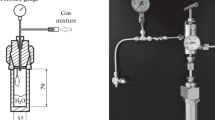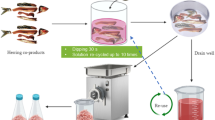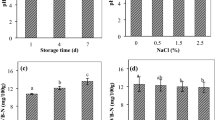Abstract
The purpose of the following research was to improve the original Celsior solution in order to obtain a higher degree of stability and effectiveness. The solution was modified by the addition of selected antioxidants such as vitamin C, cysteine, and fumaric acid in the following concentrations: 0.1, 0.3, and 0.5 mmol/l. The solution’s stability was estimated using an accelerated stability test based on changes in histidine concentrations in the solution using Pauly’s method for determining concentrations. Elevated temperatures, the factor accelerating substances’ decomposition reaction rate, were used in the tests. The research was conducted at four temperatures at intervals of 10°C: 60 ± 0.2°C, 70 ± 0.2°C, 80 ± 0.2°C, and 90 ± 0.2°C. It was stated that the studied substances’ decomposition occurred in accordance with the equation for first-order reactions. The function of the logarithmic concentration (log%C) over time was revealed to be rectilinear. This dependence was used to determine the kinetics of decomposition reaction rate parameters (the rate constant of decomposition k, activation energy E a, and frequency factor A). On the basis of these parameters, the stability of the modified solution was estimated at +5°C. The results obtained show that the proposed antioxidants have a significant effect on lengthening the Celsior solution’s stability. The best results were reached when combining two antioxidants: vitamin C and cysteine in 0.5 mmol/l concentrations. As a result, the Celsior solution’s stability was lengthened from 22 to 299 days, which is 13.5 times. Vitamin C at a concentration of 0.5 mmol/l increased the solution’s stability by 5.2 times (t 90 = 115 days), cysteine at a concentration of 0.5 mmol/l caused a 4.4 times stability increase (t 90 = 96 days), and fumaric acid at a concentration of 0.5 mmol/l extended the stability by 2.1 times (t 90 = 48 days) in relation to the original solution.



Similar content being viewed by others
References
Budziński G, Cierpka L. Methods of storing organs for transplantation purposes. In: Smorg Z, Słomki R, Cierpka L, editors. Biotechnological and medical foundations of xenotransplantation. Poznan: Ośrodek Wydawnictw Naukowych; 2006. p. 279–90.
Kosieradzki M, Danielewicz R. Ischemic damage of organs and their storage. In: Rowiński W, Wałaszewski J, Pczka L, editors. Clinical transplantology. Warsaw: Wydawnictwo Lekarskie PZWL; 2004. p. 105–21.
Ryszka F, Dolińska B, Ostróżka-Cieślik A. Solutions for organs storage purposes and evaluation of their efficiency. In: Smorg Z, Słomski R, Cierpka L, editors. Biotechnological and medical foundations of xenotransplantation. Poznan: Ośrodek Wydawnictw Naukowych; 2006. p. 291–303.
Ryszka F, Ostróżka-Cieślik A, Dolińska B. Impact of solutions components for organs storage purposes on their stability and biochemical properties. Biotechnologia 2006;1(72):97–102.
Roberts RF, Nishanian GP, Carey JN, Sakamaki Y, Starnes VA, Barr ML. A comparison of the new preservation solution Celsior to EuroCollins and University of Wisconsin solutions in lung reperfusion injury. Transplantation 1999;67(1):152–5.
Xiong L, Legagneux J, Wassef M, Oubenaissa A, Detruit H, Mouas C, et al. Protective effects of Celsior in lung transplantation. J Heart Lung Transplant 1999;18:320–7.
Janßen H, Janßen PH, Broelsch CE. Celsior solution compared with University of Wisconsin solution (UW) and histidine–tryptophan–ketoglutarate solution (HTK) in the protection of human hepatocytes against ischemia–reperfusion injury. Transpl Int 2003;16:515–22.
Howden BO, Jablonski P. Liver preservation: a comparison of Celsior to colloid-free University of Wisconsin solution. Transplantation 2000;70:1140–2.
Carrier M, Trudel S, Pelletier LC. Effect of Celsior and University of Wisconsin solutions on myocardial metabolism and function after warm ischemia. J Cardiovasc Surg (Torino). 1999;40(6):811–16.
Mohara J, Takahashi T, Oshima K, Aiba M, Yamagishi T, Takeyoshi I, et al. The effect of Celsior solution on 12-hour cardiac preservation in comparison with University of Wisconsin solution. J Cardiovasc Surg (Torino). 2001;42(2):187–92.
Abrahamse STL, Dinant S, Pfaffendorf M, Gulik TM. In vitro function of porcine carotid arteries preserved in UW, HTK and Celsior solutions. Fund Clin Pharmacol 2002;16(6):503–11.
Włodek L. Oxygen reactive species in physiological and pathological conditions. Cellular antioxidant systems. Farm Pol 2004;9:404–18.
Southard JH, Den-Butter B, Marsh DC. The role of oxygen free radicals in organ preservation. Klin Wochenschr 1991;21:1073–6.
Bilska A, Kryczyk A, Włodek L. The different aspects of the biological role of glutathione. Post Hig Med Dosw 2007;61:438–53.
Wu G, Fang YZ, Yang S, Pluton JR. Glutathione metabolism and its implications for health. J Nutr. 2004;134:489–92.
Markuszewski L, Okoński P, Banach M, Wierzbiński P, Pietruszyński R. Role of oxidative stress and reactive oxygen species in pathogenesis of stunning myocardium. Glutathione as a substance which prevents stunning. Folia Cardiol. 2006;13(1):9–18.
Włodek L. Biothols in physiological and pathological conditions and in therapy. Krakow: Wydawnictwo Uniwersytetu Jagiellońskiego; 2003. p. 7–15.
Guz J, Dziaman T, Szpila A. Do antioxidant vitamins influence carcinogenesis process? Post Hig Med Dosw. 2007;61:185–98.
Konopacka M. Function of vitamin C in oxidant damages of DNA. Post Hig Med Dosw. 2004;58:343–8.
Sies H, Stahl W, Sundquist AR. Antioxidant functions of vitamins. Vitamins E and C, beta-carotene, and other carotenoids. Ann NY Acad Sci. 1992;669:7–20.
Padayatty SJ, Katz A, Wang Y, Eck P, Kwon O, Lee J, et al. Vitamin C as an antioxidant: evaluation of its role in disease prevention. J Am Coll Nutr. 2003;22:18–35.
Sroka Z, Gamian A, Cisowski W. Low molecular antioxidant compounds of natural origin. Post Hig Med Dosw 2005;59:34–41.
Lloberas N, Torras J, Herrero-Fresneda I, Cruzado JM, Riera M, Hurtado I, Grinyo JM. Postischemic renal oxidative stress induces inflammatory response through PAF and oxidized phospholipids. Prevention by antioxidant treatment. FASEB J 2002;16:908–10.
Deutsch JC. Ascorbic acid oxidation by hydrogen peroxide. Anal Biochem 1998;255:1–7.
Kulikowska-Karpińska E, Moniuszko-Jakoniuk J. The antioxidative barrier in the organism. Pol J Environ Stud 2004;13(1):5–13.
Ziemlański Ś, Wartanowicz M. Function of nutritional antioxidants in health and disease. Pediatr Współcz Gastroenterol Hepatol Żywienie Dziecka 1999;1:97–105.
Piekutowski K, Roszkowski K. Free oxygen radicals. Protective function of antioxidant vitamins in tumors prevention and treatment. Współcz Onkol 1999;4:143–4.
Laplante A, Vincent G, Poirier M, Rosiers C. Effects and metabolism of fumarate in the perfused rat heart; A 13C mass isotopomer study. Am J Physiol 1997;272:E74–82.
Pearl JM, et al. Fumarate enriched blood cardioplegia results in complete functional recovery of immature myocardium. Ann Thorac Surg 1993;57:1636–41.
Sangstat Medical Corporation; 1999. http://www.sangstat.com/docs/celsior_pl.pdf. Accessed June 22, 2004.
Alexander RJ. A laboratory manual of analytical methods of protein chemistry. New York: Pergamon; 1970. p. 234–56.
Shi L, Schofield T. Pharmaceutical stability testing conference. Expert Opin Drug Saf 2004;3:153–8.
International Conference on Harmonization (ICH). Guidance for Industry. Q2B. Validation of Analytical Procedures: Methodology. 1996. Available at http://www.fda.gov/cder/guidance/index.htm. Accessed June 25, 2003.
Truhlar DG, Kohen A. Convex Arrhenius plots and their interpretation. PNAS. 2001;98(3):848–51.
Joule JA, Smith GF. Chemistry of heterocyclic compounds. Warsaw: PWN; 1984. p. 43.
Stanosz M, Mach-Szczypiński J, Stanosz S. Biochemical and pharmacological aspects of histamine. Gin Prakt. 2005;86(5):37–42.
Tomasik P. Mechanism of organic reactions. Warsaw: PWN; 1998. p. 26.
Bartosz G. Second nature of oxygen. Warsaw: PWN; 1995. p. 27.
Ciszewska-Jędrasik M, Pertkiewicz M. Mixtures for perentenal nutrition purposes. Warsaw: PZWL; 2004. p. 12–27.
Dolińska B, Ryszka F, Ostróżka-Cieślik A. The effect of selected antioxidants on the kinetics of changes in the stability of an HTK Solution. A technical note. AAPS PharmSciTech 2006;7(2) Article 51.
Acknowledgments
This study was funded by the State Committee for Scientific Research, Warsaw, Poland (grant PBZ-KBN-048/PO5/2001).
Author information
Authors and Affiliations
Corresponding author
Rights and permissions
About this article
Cite this article
Ostróżka-Cieślik, A., Dolińska, B. & Ryszka, F. Influence of the Selected Antioxidants on the Stability of the Celsior Solution Used for Perfusion and Organ Preservation Purposes. AAPS PharmSciTech 10, 468–475 (2009). https://doi.org/10.1208/s12249-009-9232-3
Received:
Accepted:
Published:
Issue Date:
DOI: https://doi.org/10.1208/s12249-009-9232-3




